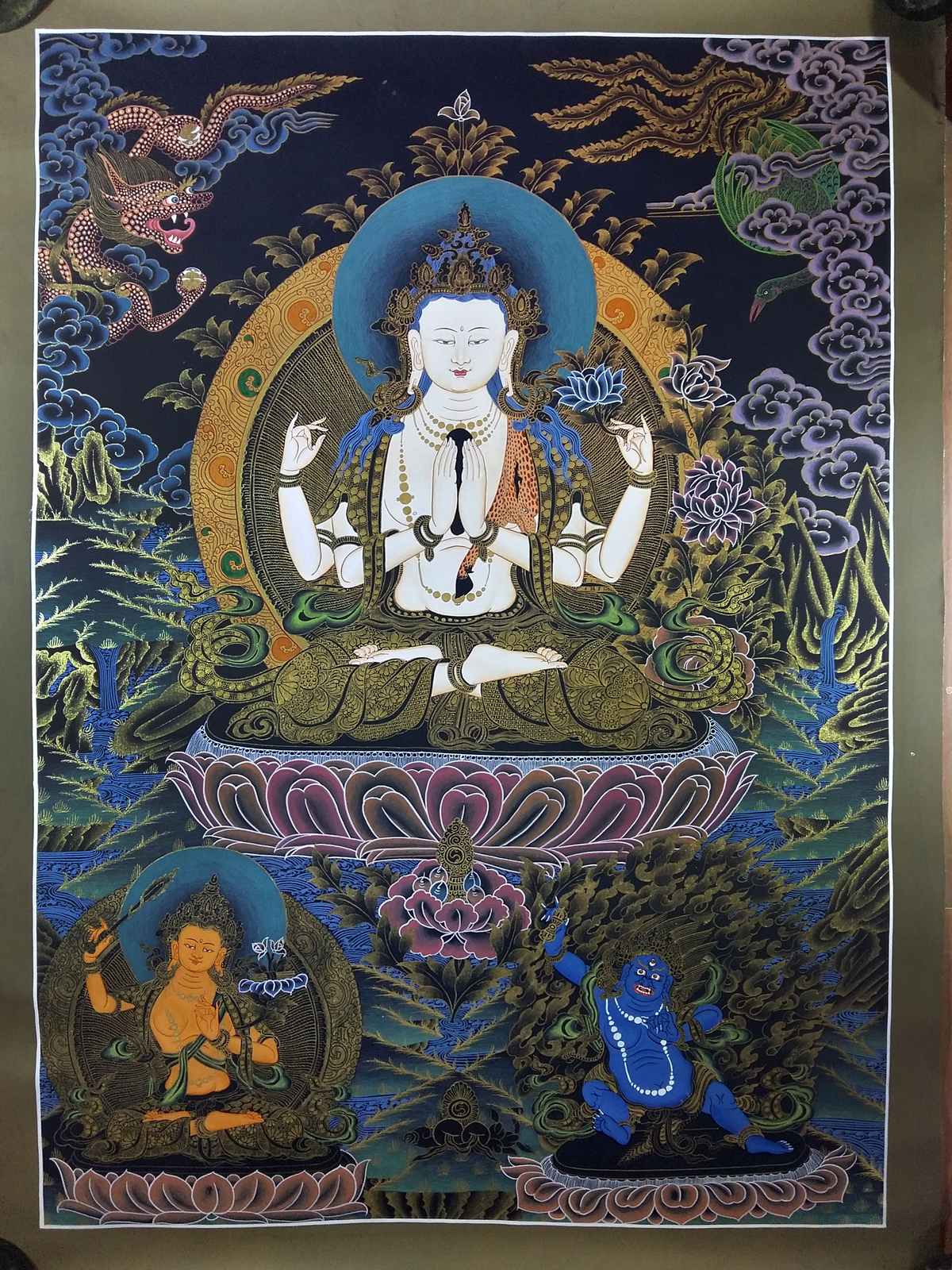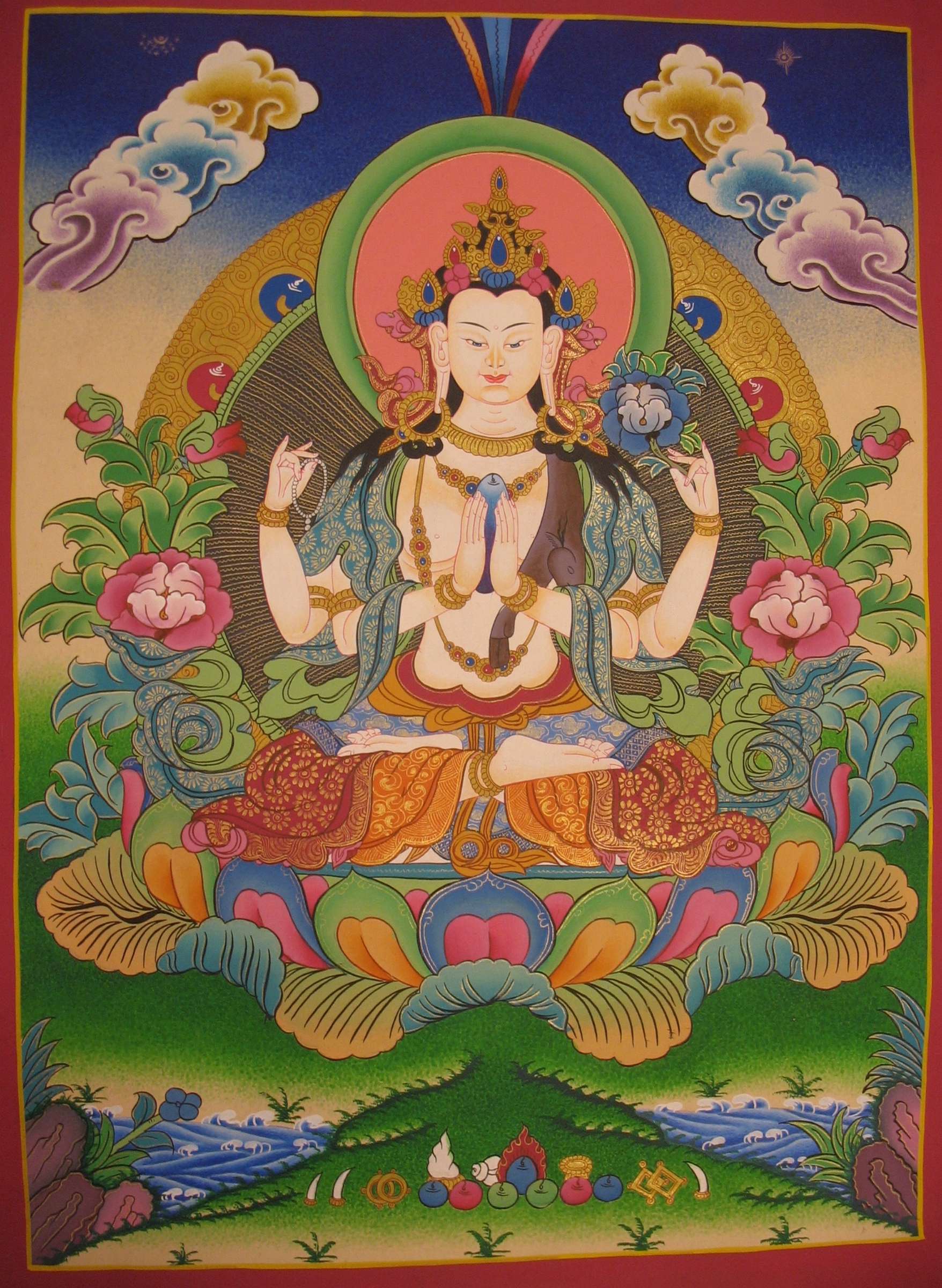

Chenrezig with 2 Offering Goddesses
Chenrezig with 2 Offering Goddesses is handpainted on cotton canvas by a Thangka artist from Nepal. Chenrezig is also known as Avalokitesvara. Chenrezig is the most revered of all Bodhisattva embodying the compassion of all Buddhas.
Chenrezig is presented at the center of the thangka. Amitabha Buddha is presented at the top of the Chenrezig in the thangka. Two offering Goddesses are presented at the bottom right and bottom left corner of the Chenrezig in the painting.
Gren Tara is presented at the top right corner of the Chenrezig in the painting. White Tara is presented at the top left corner of the Chenrezig in the painting.
Iconography of Amitabha buddha
Amitabha Buddha is presented at the top of the Chenrezig in the Painting. Amitabha is head of the Lotus Family, one of the oldest & significant of the Five Buddha Families. This family represents love, purity, compassion & peace. Amitabha Purelandis a place of infinite bliss & boundless light.
Amitabha Buddha is also one of the five Tathagatas representing the wisdoAmitabha Buddha is also one of the five Tathagatas representing the wisdom of discriminating awareness. Amitabha Buddha is red in color. He is represented in the stupa facing to the west. He rides on a peacock symbolizing that he can take away the suffering of others just as the peacock eats poisonous plants and yet his tail shines forth.
Mantra of Amitabha Buddha
The mantra of Amitabha Buddha is Om ami dewa hr.
Iconography of Green Tara
Gren Tara is presented at the top right corner of the Chenrezig in the painting. She is shown with a benevolent countenance seated upon a white moon disk which is associated with special restorative nectar associated with the naval chakra center. In Buddhists, the moon symbolizes the wisdom aspect which when coupled with compassion leads to Sakyamuni Buddha's enlightenment. Her right hand is gracefully lowered in Varada mudra, the boon-granting gesture.
Green Tara's special lotus is the blue lotus or 'night lotus' which she bears in both hands. The word Utpala means to 'burst open'. Her left-hand holds a stem with an open blooming flower and an unopened bud. The bent lower part of the stem represents the root.
The open blossom represents the present and also the present Buddha; the bud represents the future and also Buddhas yet to be born. The future here also refers to a safe journey's end and a future well being. Her right-hand wisdom hand is in the gesture of giving refuge.
The third finger touches the thumb to create a circle representing the union of wisdom and compassion, and the three extended fingers symbolize the Three Jewels of Buddhism a. The Buddha State b. The Body of teachings c.
The Principles of the Universe The same hand holds the stem of a blue lotus representing her willingness to assist. The closed blossom in her right hand represents the past and also the Buddhas of the past. Green Tara is shown in a place of paradise called Khadiravani where Tara dwells. Khadiravani is described as a great mountain kingdom with many trees, flowers, and animals rainbow tails emanate from her outer aureole. The crescent moon and sun symbolize the union of male and female ubiquitous in Tantric art.
Mantra of Green Tara
The mantra of Green Tara is om tare tuttare ture soha.
Iconography of White Tara
White Tara is presented at the top left corner of the Chenrezig in the painting. White Tara's embodiment of peace directed through loving compassion. From her serenity, she lends grace and dignity to situations and encourages the good to arise in all circumstances and situations.
The extra eye on her forehead, on the palms of her hands & the soles of her feet, represent her ability to see and understand the sufferings of all beings & her omniscient compassion toward the suffering.
Mantra of White Tara
The mantra of White Tara is Om Tare Tuttare Ture Mama Ayur Pune Gyana Puntin Kuru Swoha.












